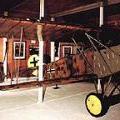 Like most kids, when I was growing up, I enjoyed reading Peanuts, especially the adventures of Snoopy and the Red Baron, which were based on the German fighter ace Manfred von Richthofen and his World War I exploits. It's funny how something from your childhood you had forgotten can suddenly come back to life. This is what happened when I visited the Brome County Museum in Knowlton, where I was greeted by curator Arlene Royea and shown a rare Fokker DVII World War I fighter plane.
Like most kids, when I was growing up, I enjoyed reading Peanuts, especially the adventures of Snoopy and the Red Baron, which were based on the German fighter ace Manfred von Richthofen and his World War I exploits. It's funny how something from your childhood you had forgotten can suddenly come back to life. This is what happened when I visited the Brome County Museum in Knowlton, where I was greeted by curator Arlene Royea and shown a rare Fokker DVII World War I fighter plane.
MACHINE GUNS
The Fokker was designed and produced by Dutch inventor Anthony Fokker and was sold to the German High Command in 1918. Fokker had approached the Allies first but was turned down. His DVIIs were single-seater biplanes with twin machine guns facing forward of the cockpit directly towards the propeller. Amazingly, it was possible to synchronize the machine guns with an interrupter gear that regulated the guns' fire, thus allowing the bullets to pass between the blades of the propeller without shooting them apart.
"You'd want to make sure that the machine guns were properly synchronized before taking off, otherwise you might be in for a little trouble once you got into combat," Royea said pointing out the guns that are still mounted on the cockpit. "Otherwise, you might shoot yourself down, and it wouldn't make for a good day."
Fokker DVIIs, like the one at the Brome County Museum, were powered by 160-horsepower Mercedes-Benz engines which gave the planes a top speed of 188 km (117 miles) per hour. The planes were much faster and could climb higher than the allies' aircraft, so they helped the Germans dominate aerial reconnaissance, artillery spotting, and combat. This advantage came a little too late, however, because the Germans were losing the ground war by that time.
WAR TROPHY
The Brome County Museum obtained its plane through the efforts of Senator George G. Foster who wrote to Ottawa asking if war trophies could be sent to Knowlton. In 1920, Foster arranged for the biplane to be shipped from Camp Borden, Ontario to the museum in Knowlton. There the relic would be the centrepiece of the museum's war display in the Martin Annex, which was officially opened in 1921 by the Rt. Hon. Sir Robert Borden, Canada's wartime Prime Minister.
The Fokker in Knowlton is the only one to survive out of twenty-two that were shipped to Canada after World War I as war trophies. It may have been among those used by Billy Bishop when he toured the country giving air shows after the war. Today, it is the only completely original one of its kind in North America and one of only three in the world.